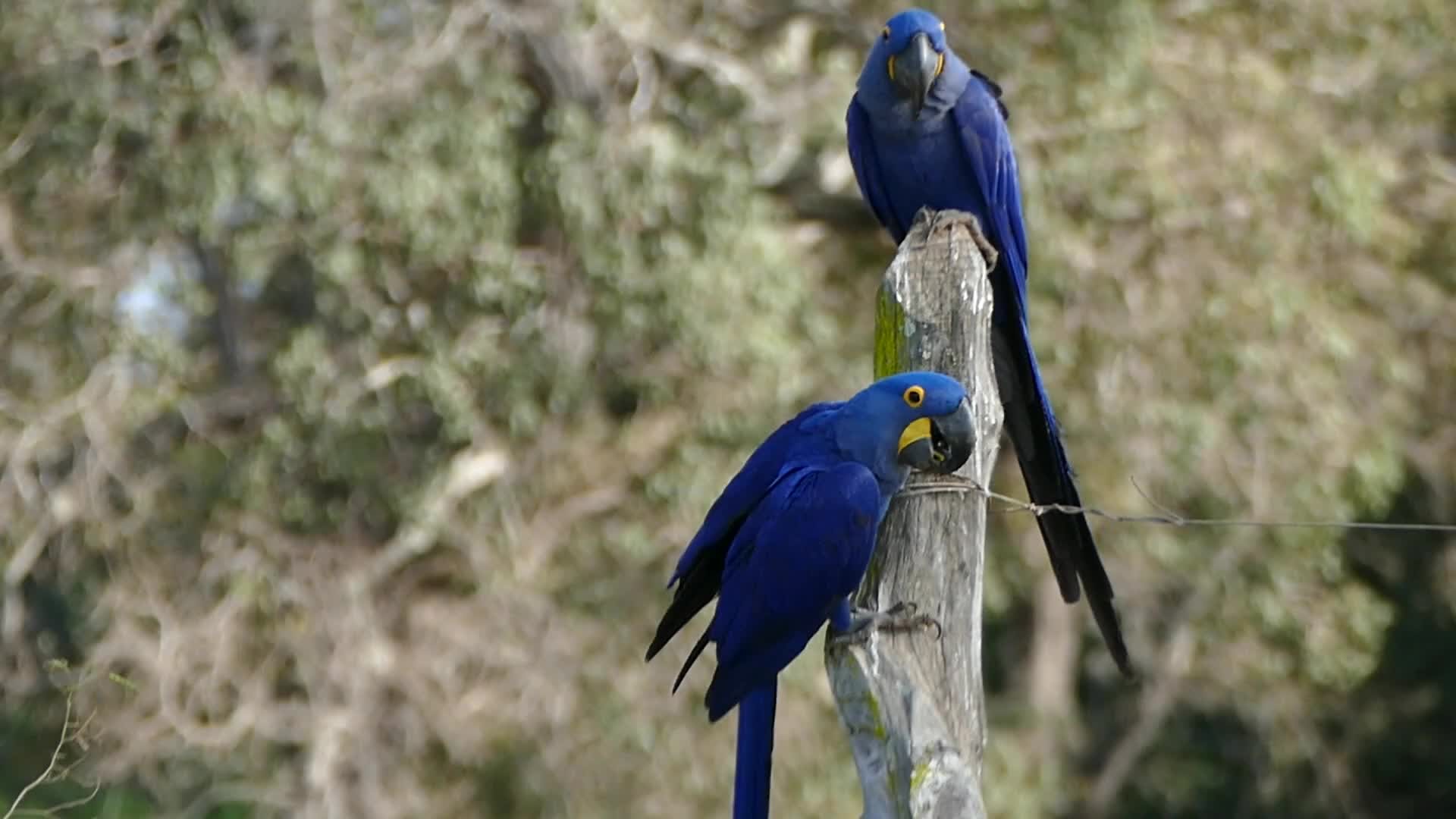Hyacinth Macaw
A species of Blue Macaws Scientific name : Anodorhynchus hyacinthinus Genus : Blue Macaws
Hyacinth Macaw, A species of Blue Macaws
Botanical name: Anodorhynchus hyacinthinus
Genus: Blue Macaws
Content
Description People often ask General Info
 Photo By Bernard DUPONT , used under CC-BY-SA-2.0 /Cropped and compressed from original
Photo By Bernard DUPONT , used under CC-BY-SA-2.0 /Cropped and compressed from original Description
The largest parrot by length in the world, the hyacinth macaw is 1 m (3.3 ft) long from the tip of its tail to the top of its head and weighs 1.2–1.7 kg (2.6–3.7 lb). Each wing is 38.8–42.5 cm (15.3–16.7 in) long. The tail is long and pointed. Its feathers are entirely blue, lighter above. However, the neck feathers can sometimes be slightly grey. The ring around the parrots eyes and area just underneath the beak are a strong, vibrant yellow. 
Size
1 m
Colors
Black
Yellow
Blue
Life Expectancy
60 years
Nest Placement
Tree
Feeding Habits
Hyacinth Macaw primarily consumes Brazil nuts, particularly from acuri and bocaiuva palms, utilizing its strong beak to crack tough shells. It also eats fruits, seeds, and nectar, and specifically forages for ripe foods across vast areas. Unique adaptations include its ability to consume acuri nuts only after cattle digestion and its dry, bone-enhanced tongue for fruit consumption. In captivity, macadamia nuts substitute for native palm nuts.
Habitat
The hyacinth Macaw predominantly inhabits semiopen woodlands, palm swamps, and savannah grasslands, with a preference for areas where suitable palm food plants, such as the Mauritia flexuosa, are abundant. These birds thrive in the edge of tropical moist lowland forests and open dry woodlands interspersed with gallery forests. They tend to avoid dense, humid forests, favoring regions offering open spaces along major rivers. Broader geographical regions where the hyacinth Macaw is found include parts of South America's Pantanal, Cerrado regions, and the eastern Amazon Basin's relatively open areas.
Dite type
Granivorous
People often ask
General Info
Feeding Habits
Bird food type
Distribution Area
The hyacinth macaw survives today in three main populations in South America: In the Pantanal region of Brazil, and adjacent eastern Bolivia and northeastern Paraguay, in the Cerrado region of the eastern interior of Brazil (Maranhão, Piauí, Bahia, Tocantins, Goiás, Mato Grosso, Mato Grosso do Sul, and Minas Gerais), and in the relatively open areas associated with the Tocantins River, Xingu River, Tapajós River, and the Marajó island in the eastern Amazon Basin of Brazil. Smaller, fragmented populations may occur in other areas. It prefers palm swamps, woodlands, and other semiopen, wooded habitats. It usually avoids dense, humid forest, and in regions dominated by such habitats, it is generally restricted to the edge or relatively open sections (e.g. along major rivers). In different areas of their range, these parrots are found in savannah grasslands, in dry thorn forest known as caatinga, and in palm stands, particularly the Moriche Palm (Mauritia flexuosa). The hyacinth macaw has escaped or been deliberately released in to Florida, USA, but there is no evidence that the population is breeding and may only persist due to continuing releases or escapes. 
Species Status
The hyacinth macaw is an endangered species due to the cage bird trade and habitat loss. In the 1980s, an estimated 10,000 birds were taken from the wild and at least 50% were destined for the Brazilian market. Throughout the macaw's range, habitat is being lost or altered due to the introduction of cattle ranching and mechanised agriculture, and the development of hydroelectric schemes. Annual grass fires set by farmers can destroy nest trees, and regions previously inhabited by this macaw are now unsuitable also due to agriculture and plantations. Locally, it has been hunted for food, and the Kayapo Indians of Gorotire in south-central Brazil use its feathers to make headdresses and other ornaments. While overall greatly reduced in numbers, it remains locally common in the Brazilian Pantanal, where many ranch-owners now protect the macaws on their land. The hyacinth macaw is protected by law in Brazil and Bolivia, and commercial export is banned by its listing on Appendix I of the CITES. A number of long-term studies and conservation initiatives are in place; the Hyacinth Macaw Project in the Brazilian state of Mato Grosso do Sul has carried out important research by ringing individual birds, and has created a number of artificial nests to compensate for the small number of sites available in the region. The Minnesota Zoo with BioBrasil and the World Wildlife Fund are involved in hyacinth macaw conservation. 